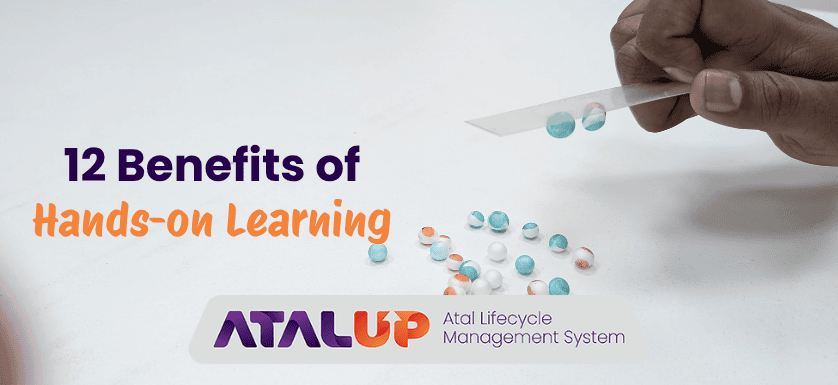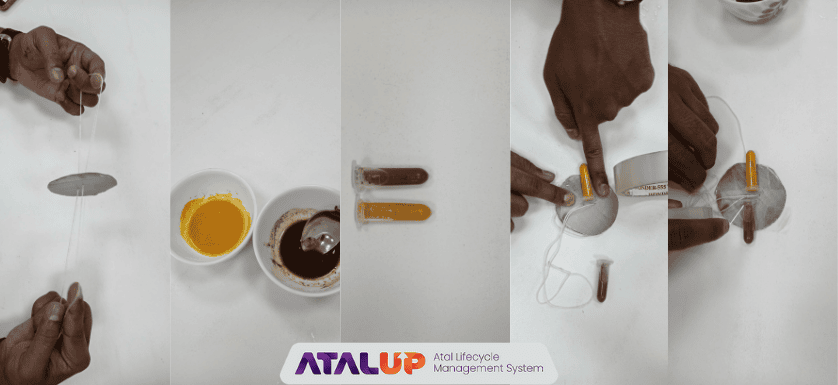
Wonder why hands-on learning is important for India’s school students? This is how our students learn centrifugal force: “Centrifugal force is not a real force but an applied force. When an object experiences an outward force while moving in a circular path, it is called centrifugal force.”
But when a kid performs a STEM activity using household tools and watches the disposed soil separating from water, the kid remembers it for a lifetime. Not only remembers, but understands. Then the kid connects the dots and observes, “Hey, this same force is used in a washing machine…” That’s the power of learning by doing.

Hands-on Learning Meaning
Hands-on learning means learning by actively engaging in tasks, projects, and real-world experiences. Instead of just listening to lectures or memorizing content from books, students explore subjects by doing. They conduct experiments, build models, design prototypes, and participate in simulations. This method helps them understand concepts more deeply because they are learning by experiencing, not just observing.
Hands-on learning also includes problem-solving, teamwork, and experimenting with trial and error. It creates a space where students make connections between what they study and how it applies to real life. Whether it’s measuring ingredients in a cooking activity to learn math or building a robot to understand coding, practical learning brings the subject alive.
Has NEP 2020 Introduced Hands On Learning?
Yes, the National Education Policy (NEP) 2020 emphasizes hands-on learning at all levels of education. It moves away from traditional rote learning and encourages more practical, inquiry-based, and experiential methods. NEP 2020 talks about introducing vocational training, coding, digital literacy, and project-based assessments. It supports activity-based pedagogy, allowing students to participate in science experiments, artistic expressions, group projects, and field visits.
The goal of NEP is to make learning more joyful, meaningful, and skill-driven. By promoting hands-on learning, NEP 2020 prepares students for real-world challenges by helping them learn by doing, exploring, and questioning.
Does Hands-On Learning Help Students Learn Better?
Yes, hands-on learning significantly improves the way students grasp and retain information. When learners physically interact with materials, their brains process and store the information more effectively. It creates stronger memory connections because they are not just reading or hearing the concept; they are experiencing it.
For example, when a student builds a solar oven to understand heat energy, they don’t just memorize the concept of conduction and insulation. They feel it, test it, and remember it. This process also makes learning enjoyable, keeping students motivated and engaged. Hands-on learning helps students become active participants rather than passive listeners, improving both understanding and long-term retention.
12 Benefits of Hands-On Learning
1. Better Learning of Concepts
Students remember lessons more clearly when they interact physically with the subject. Instead of memorizing facts, they experience how things work. For instance, using LEGO blocks to learn math concepts like volume or area improves recall through physical demonstration.
2. Stronger Critical Thinking Skills
When students are involved in experiments or challenges, they think on their feet. They evaluate options, consider consequences, and make decisions. Hands-on learning builds logical reasoning and helps them analyze situations with a deeper understanding.
3. Higher Student Engagement
Hands-on activities keep students focused and curious. Activities like science experiments or creating models keep their minds active. Instead of just copying notes, they are involved in meaningful tasks that hold their interest.
4. Boost in Creativity and Imagination
When students are allowed to build, design, and invent, they come up with new ideas. Whether it’s creating a water filter using simple tools or designing a unique mobile app, hands-on learning gives them the freedom to explore their creativity.
5. Increased Confidence and Self-Esteem
Completing a hands-on project successfully gives students a sense of achievement. They feel proud of what they’ve built or discovered. This boosts their confidence and encourages them to take on new challenges with a positive attitude.
6. Improved Collaboration and Teamwork
Many hands-on learning activities involve group work. This helps students learn how to communicate, divide tasks, and respect different viewpoints. They learn that working as a team can lead to better solutions and new ideas.
7. Curiosity-Driven Learning
When students get their hands involved, questions naturally arise. They wonder why something works a certain way or what would happen if they tried it differently. This curiosity drives them to dig deeper into topics and ask meaningful questions.
8. Bridge Between Theory and Practice
Hands-on learning helps students apply what they read in textbooks to real-life situations. For example, instead of just reading about electricity, they build a working circuit. This bridge between theory and application strengthens understanding.
9. Personalized Learning Experience
Every student learns at their own pace. With hands-on learning, they can explore topics in a way that suits them best. Some may prefer building models, others might enjoy drawing or coding. This approach respects individual learning styles.
10. Problem-Solving Skills and Resilience
Hands-on learning teaches students that failure is part of the process. When a project doesn’t work the first time, they troubleshoot, adapt, and try again. This builds resilience and teaches them how to solve problems with a positive mindset.
11. Real-World Readiness
By working on real tasks and building tangible solutions, students are better prepared for future jobs. They learn how to think like engineers, designers, entrepreneurs, or scientists. It shapes them for a world that values skills over memorized facts.
12. Love for Learning
Most importantly, hands-on learning makes education fun and meaningful. When students enjoy what they’re doing, they naturally become lifelong learners. This joy in learning stays with them well beyond school.
How is Atal Innovation Mission Enabling Hands-On Learning Through ATL Labs?
The Atal Innovation Mission (AIM) by NITI Aayog has made a huge impact by setting up Atal Tinkering Labs (ATLs) in schools across India. These labs are designed to promote hands-on learning among school students, especially in the fields of science, technology, engineering, and mathematics (STEM).
ATLs are equipped with modern tools such as 3D printers, robotics kits, electronics, mechanical equipment, and DIY modules. Students use these tools to create projects, solve local problems, and innovate with their own ideas. AIM also runs regular innovation challenges, mentorship programs, and online learning platforms, making hands-on learning accessible to even rural schools.
Through ATL Labs, students are not just passive learners. They become makers, creators, and problem-solvers. The initiative breaks the boundaries of classroom learning and encourages students to build real-world solutions that matter.
Final Words
ATALUP helps schools make the most of their Atal Tinkering Labs. It offers a complete management and learning system to run ATL Labs effectively. With ATALUP, schools can ensure hands-on learning becomes a regular, structured, and impactful part of every student’s journey.